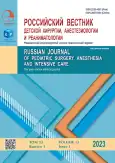Cross-fused dystopia of the right kidney with cystic dysplasia of the non-functioning left kidney associated with an ureterocele
- Authors: Kuzovleva G.I.1,2, Rogozhina V.V.2, Staroverov O.V.1, Ayryan E.K.1,2, Khvatynets N.А.1,2, Rostovskaya V.V.2
-
Affiliations:
- Speransky Children’s Hospital No. 9
- I.M. Sechenov First Moscow State Medical University (Sechenov University)
- Issue: Vol 13, No 1 (2023)
- Pages: 95-104
- Section: Case reports
- URL: https://journals.rcsi.science/2219-4061/article/view/132764
- DOI: https://doi.org/10.17816/psaic1488
- ID: 132764
Cite item
Full Text
Abstract
Cross-dystopia is a rare type of congenital anomaly and is characterized by a displacement of the kidney to the opposite side; as a result, they are both located on the same side, and in approximately 85% of such cases, a fusion of the parenchyma of two kidneys can be observed. We have not found reports of cases in which a nonfunctioning orthotopic cystic dysplastic kidney associated with ureterovesical segment pathology (ureterocele) was fused with the lower pole of a cross-dystopian normally formed kidney in the literature. The patient, 8 days old, had a preliminary diagnosis of agenesis of the right kidney, doubling of the left kidney, cystic dysplasia, doubled left kidney with an ureterohydronephrosis in the lower half and ureterocele. To restore the urine outflow and function of the lower half of the presumably doubled left kidney, a cystourethroscopy was performed. In a typical place on the right, there was a correctly formed ureteral orifice, i.e., an ureterocele on the left, which occupies half of the bladder volume. With a holmium laser, an artificial orifice was formed in the ureterocele to restore the urine passage. At 9 months old, tomography urinary tract was performed, which revealed cross-dystopia of the right kidney with a fusion of the lower pole and a cystic dysplastic orthotopic left kidney. Laparoscopic nephroureterectomy of a non-functioning orthotopic kidney was performed.
The control examination indicated complete clinical remission and social adaptation of the patient after discharge. Cross-dystopia of the kidney with fusion, cystic dysplastic kidney, and a ureterocele are rare congenital anomalies that require timely examination in a specialized clinic and drawing up an individual treatment plan. The surgical method should focus on a symptomatic urological problem, emphasizing preserving kidney function.
Keywords
Full Text
##article.viewOnOriginalSite##About the authors
Galina I. Kuzovleva
Speransky Children’s Hospital No. 9; I.M. Sechenov First Moscow State Medical University (Sechenov University)
Email: dr.gala@mail.ru
ORCID iD: 0000-0002-5957-7037
SPIN-code: 7990-4317
MD, Cand. Sci. (Med)., paediatric urologist; assistant of the L.P. Alexandrov Department of pediatric surgery, urology and andrology
Russian Federation, Moscow; MoscowVeronika V. Rogozhina
I.M. Sechenov First Moscow State Medical University (Sechenov University)
Author for correspondence.
Email: rogozhina_v_v@student.sechenov.com
ORCID iD: 0000-0001-9229-8745
student
Russian Federation, MoscowOleg V. Staroverov
Speransky Children’s Hospital No. 9
Email: staroverov2002@mail.ru
ORCID iD: 0000-0001-9528-7056
SPIN-code: 5517-1191
MD, Cand. Sci. (Med)., head of urological and andrological Departament No. 2
Russian Federation, MoscowEduard K. Ayryan
Speransky Children’s Hospital No. 9; I.M. Sechenov First Moscow State Medical University (Sechenov University)
Email: edikayryan@mail.ru
ORCID iD: 0000-0002-8267-0205
SPIN-code: 9226-2200
MD, Cand. Sci. (Med), assistant professor of the L.P. Alexandrov Department of Pediatric Surgery, Urology and Andrology
Russian Federation, Moscow; MoscowNikolay А. Khvatynets
Speransky Children’s Hospital No. 9; I.M. Sechenov First Moscow State Medical University (Sechenov University)
Email: dr.khvatynets@mail.ru
ORCID iD: 0000-0002-9007-6265
SPIN-code: 9082-7118
MD, Cand. Sci. (Med), pediatric urologist; assistant of the L.P. Alexandrov Department of Pediatric Surgery, Urology and Andrology
Russian Federation, Moscow; MoscowVera V. Rostovskaya
I.M. Sechenov First Moscow State Medical University (Sechenov University)
Email: rostovskaya_vera@mail.ru
ORCID iD: 0000-0002-3718-8911
SPIN-code: 6989-5041
MD, Dr. Sci. (Med.), professor of the Department of Pediatric Surgery, Urology and Andrology
Russian Federation, MoscowReferences
- Barakat AJ, Drougas JG. Occurrence of congenital abnormalities of kidney and urinary tract in 13,775 autopsies. Urology. 1991;38(4):347–350. doi: 10.1016/0090-4295(91)80150-6
- Sarhan O, El Helaly A, Al Otay A, et al. Crossed fused renal ectopia: Diagnosis and prognosis as a single-center experience. J Pediatr Surg. 2021;56(9):1632–1637. doi: 10.1016/j.jpedsurg.2020.08.030
- Benz-Bohm G. Anomalies of Kidney Rotation, Position and Fusion. Fotter R., editor. Pediatric uroradiology. 2nd ed. Berlin: Springer, 2008. P. 81–88. doi: 10.1007/978-3-540-33005-9_4
- Guarino N, Tadini B, Camardi P, et al. The incidence of associated urological abnormalities in children with renal ectopia. J Urol. 2004;172(4-2):1757–1759. doi: 10.1097/01.ju.0000138376.93343.74
- Boyan N, Kubat H, Uzum A. Crossed renal ectopia with fusion: Report of two patients. Clin Anat. 2007;20(6):699–702. doi: 10.1002/ca.20464
- Loganathan AK, Bal HS. Crossed fused renal ectopia in children: a review of clinical profile, surgical challenges, and outcome. J Pediatr Urol. 2019;15(4):315–321. doi: 10.1016/j.jpurol.2019.06.019
- McDonald JH, McClellan DS. Crossed renal ectopia. Am J Surg. 1957;93(6):995–1002. doi: 10.1016/0002-9610(57)90680-3
- Akdogan L, Oguz AK, Ergun T, Ergun I. The Rarest of the Rare: Crossed Fused Renal Ectopia of the Superior Ectopia Type. Case Rep Nephrol. 2015;2015:742419. doi: 10.1155/2015/742419
- Somiya S, Takahashi T, Ito K, et al. Retrograde ureteroscopic lithotripsy in cross-fused renal ectopia. IJU Case Rep. 2021;4(4):232–234. doi: 10.1002/iju5.12295
- Bernstein J. Developmental abnormalities of the renal parenchyma-renal hypoplasia and dysplasia. Pathol Ann. 1968;3:213–247.
- Meyers ML, Treece AL, Brown BP, Vemulakonda VM. Imaging of fetal cystic kidney disease: multicystic dysplastic kidney versus renal cystic dysplasia. Pediatr Radiol. 2020;50(13):1921–1933. doi: 10.1007/s00247-020-04755-5
- Andreeva EF, Savenkova ND. Cystic kidney desease in childhood (review of literature). Nephrology (Saint-Petersburg). 2012;16(3-2):34–47. (In Russ.) doi: 10.24884/1561-6274-2012-16-3/2-34-47
- Tang L, Koshy J, Spevak MR, et al. Diagnosis of Rare Association of Orthotopic Multicystic Dysplasia with Crossed Fused Renal Ectopia. Case Rep Urol. 2014;2014:140850. doi: 10.1155/2014/140850
- Caldamone AA, Rabinowitz R. Crossed fused renal ectopia, orthotopic multicystic dysplasia and vaginal agenesis. J Urol. 1981;126(1):105–107. doi: 10.1016/s0022-5347(17)54401-8
- Chwalla R. Eine bemerkenswerte Anomalie der Harnblase bei einem menschlichen Embryo von 32,5 mm St.Sch.L. Virchows Arch path Anat. 1927;263:632–648. doi: 10.1007/BF01890060
Supplementary files












